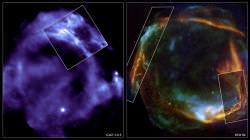Here are two images of supernova remnants, made with combined data from NASA’s Chandra X-Ray Observatory and ESA’s XMM-Newton. For both of these images, XMM-Newton captured the wider field view, while Chandra focused in on key regions of interest to researchers.
The orange object on the right is RCW 86, one of the earliest supernovae ever recorded. Historians think that explosion of the central coincides with observations made by Chinese and Roman astronomers in 185 AD. Under the combined view of Chandra and XMM-Newton, you can see the expanding ring of debris that was created after massive star detonated.
The other object is G347.3-0.5; it was also observed by the Chinese in 393 AD. The exploding star was so bright, it was said to have blazed for months, and rivaled Jupiter in brilliance. The point source in the lower section of the image is probably the original neutron star; all that remains after the massive star’s core collapsed.
In both Chandra and XMM-Newton, the intensity of X-rays is represented by the brightness of the colour.
Original Source:Chandra News Release

